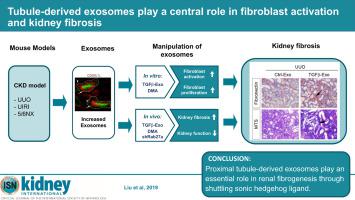当前位置:
X-MOL 学术
›
Kidney Int.
›
论文详情
Our official English website, www.x-mol.net, welcomes your
feedback! (Note: you will need to create a separate account there.)
Tubule-derived exosomes play a central role in fibroblast activation and kidney fibrosis.
Kidney International ( IF 14.8 ) Pub Date : 2019-12-17 , DOI: 10.1016/j.kint.2019.11.026 Xi Liu 1 , Jinhua Miao 1 , Cong Wang 1 , Shan Zhou 1 , Shuangqin Chen 1 , Qian Ren 1 , Xue Hong 1 , Yongping Wang 1 , Fan Fan Hou 2 , Lili Zhou 1 , Youhua Liu 3
Kidney International ( IF 14.8 ) Pub Date : 2019-12-17 , DOI: 10.1016/j.kint.2019.11.026 Xi Liu 1 , Jinhua Miao 1 , Cong Wang 1 , Shan Zhou 1 , Shuangqin Chen 1 , Qian Ren 1 , Xue Hong 1 , Yongping Wang 1 , Fan Fan Hou 2 , Lili Zhou 1 , Youhua Liu 3
Affiliation

|
Extracellular vesicles such as exosomes are involved in mediating cell-cell communication by shuttling an assortment of proteins and genetic information. Here, we tested whether renal tubule-derived exosomes play a central role in mediating kidney fibrosis. The production of exosomes was found to be increased in the early stage of unilateral ureteral obstruction, ischemia reperfusion injury or 5/6 nephrectomy models of kidney disease. Exosome production occurred primarily in renal proximal tubular epithelium and was accompanied by induction of sonic hedgehog (Shh). In vitro, upon stimulation with transforming growth factor-β1, kidney proximal tubular cells (HKC-8) increased exosome production. Purified exosomes from these cells were able to induce renal interstitial fibroblast (NRK-49F) activation. Conversely, pharmacologic inhibition of exosome secretion with dimethyl amiloride, depletion of exosome from the conditioned media or knockdown of Shh expression abolished the ability of transforming growth factor-β1-treated HKC-8 cells to induce NRK-49F activation. In vivo, injections of tubular cell-derived exosomes aggravated kidney injury and fibrosis, which was negated by an Shh signaling inhibitor. Blockade of exosome secretion in vivo ameliorated renal fibrosis after either ischemic or obstructive injury. Furthermore, knockdown of Rab27a, a protein that is essential for exosome formation, also preserved kidney function and attenuated renal fibrotic lesions in mice. Thus, our results suggest that tubule-derived exosomes play an essential role in renal fibrogenesis through shuttling Shh ligand. Hence, strategies targeting exosomes could be a new avenue in developing therapeutics against renal fibrosis.
中文翻译:

肾小管来源的外来体在成纤维细胞活化和肾纤维化中起着核心作用。
诸如外泌体的细胞外囊泡通过穿梭各种蛋白质和遗传信息参与介导细胞间的通讯。在这里,我们测试了肾小管衍生的外来体是否在介导肾纤维化中起核心作用。发现在单侧输尿管阻塞,局部缺血再灌注损伤或肾脏疾病的5/6肾切除术模型的早期阶段,外泌体的产生增加。外泌体的产生主要发生在肾近端肾小管上皮,并伴有声波刺猬(Shh)的诱导。在体外,在用转化生长因子-β1刺激后,肾近端肾小管细胞(HKC-8)增加了外泌体的产生。从这些细胞中纯化出的外泌体能够诱导肾间质成纤维细胞(NRK-49F)活化。反过来,用阿米洛利二甲基酯抑制外泌体分泌的药理作用,从条件培养基中耗尽外泌体或抑制Shh表达消除了转化生长因子-β1处理的HKC-8细胞诱导NRK-49F活化的能力。在体内,肾小管细胞源性外泌体的注射加重了肾脏的损伤和纤维化,这被Shh信号抑制剂所抵消。体内外泌体分泌的阻断改善了缺血性或阻塞性损伤后的肾纤维化。此外,敲除Rab27a(一种外泌体形成必不可少的蛋白质)还可以保留小鼠的肾功能并减轻肾脏纤维化病变。因此,我们的结果表明,肾小管来源的外来体通过穿梭Shh配体在肾纤维化中起重要作用。因此,
更新日期:2019-12-17
中文翻译:

肾小管来源的外来体在成纤维细胞活化和肾纤维化中起着核心作用。
诸如外泌体的细胞外囊泡通过穿梭各种蛋白质和遗传信息参与介导细胞间的通讯。在这里,我们测试了肾小管衍生的外来体是否在介导肾纤维化中起核心作用。发现在单侧输尿管阻塞,局部缺血再灌注损伤或肾脏疾病的5/6肾切除术模型的早期阶段,外泌体的产生增加。外泌体的产生主要发生在肾近端肾小管上皮,并伴有声波刺猬(Shh)的诱导。在体外,在用转化生长因子-β1刺激后,肾近端肾小管细胞(HKC-8)增加了外泌体的产生。从这些细胞中纯化出的外泌体能够诱导肾间质成纤维细胞(NRK-49F)活化。反过来,用阿米洛利二甲基酯抑制外泌体分泌的药理作用,从条件培养基中耗尽外泌体或抑制Shh表达消除了转化生长因子-β1处理的HKC-8细胞诱导NRK-49F活化的能力。在体内,肾小管细胞源性外泌体的注射加重了肾脏的损伤和纤维化,这被Shh信号抑制剂所抵消。体内外泌体分泌的阻断改善了缺血性或阻塞性损伤后的肾纤维化。此外,敲除Rab27a(一种外泌体形成必不可少的蛋白质)还可以保留小鼠的肾功能并减轻肾脏纤维化病变。因此,我们的结果表明,肾小管来源的外来体通过穿梭Shh配体在肾纤维化中起重要作用。因此,











































 京公网安备 11010802027423号
京公网安备 11010802027423号